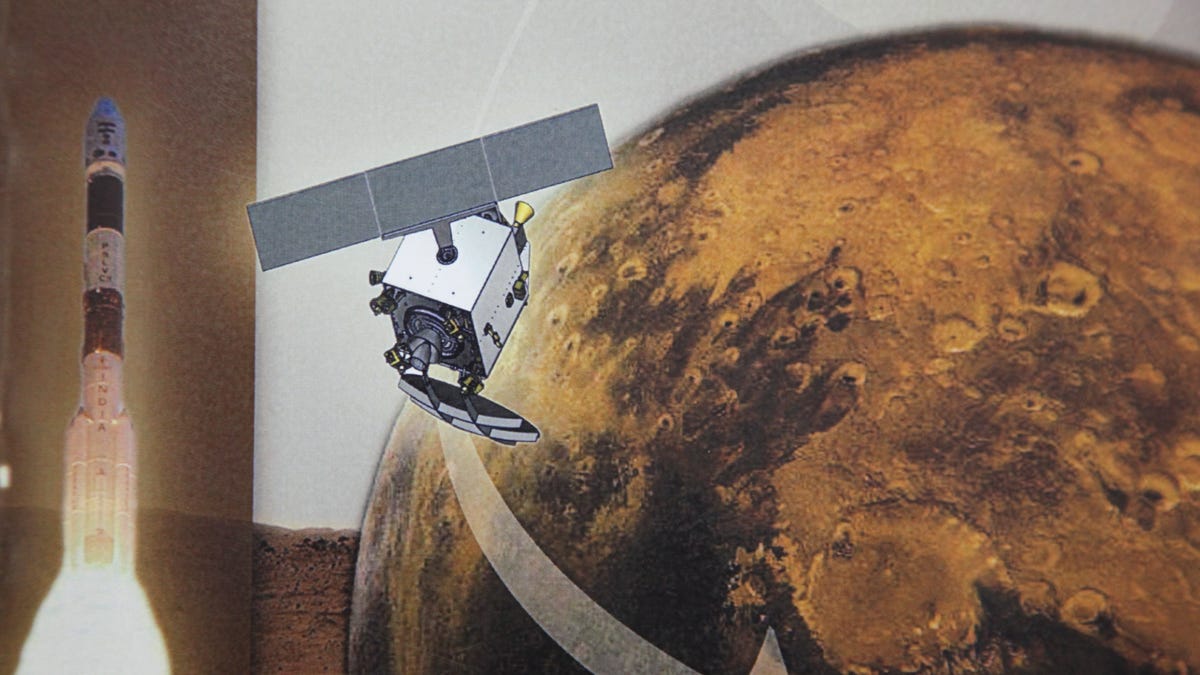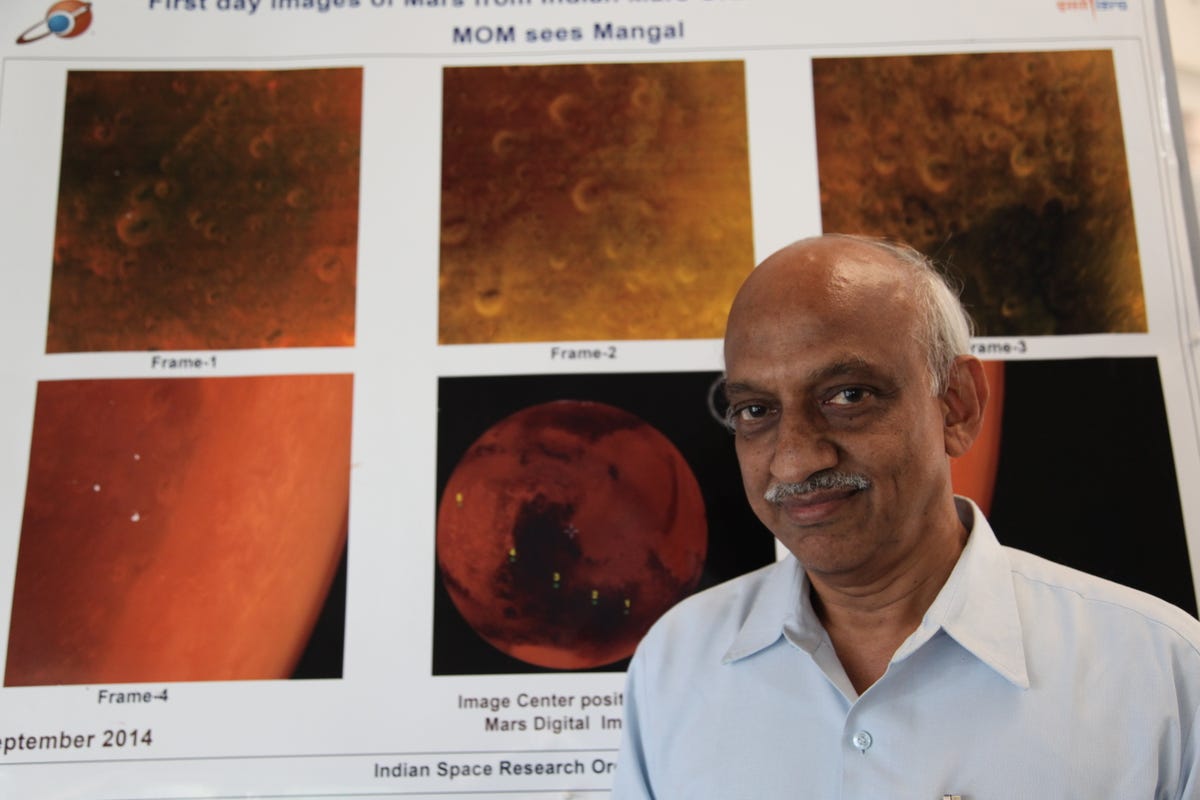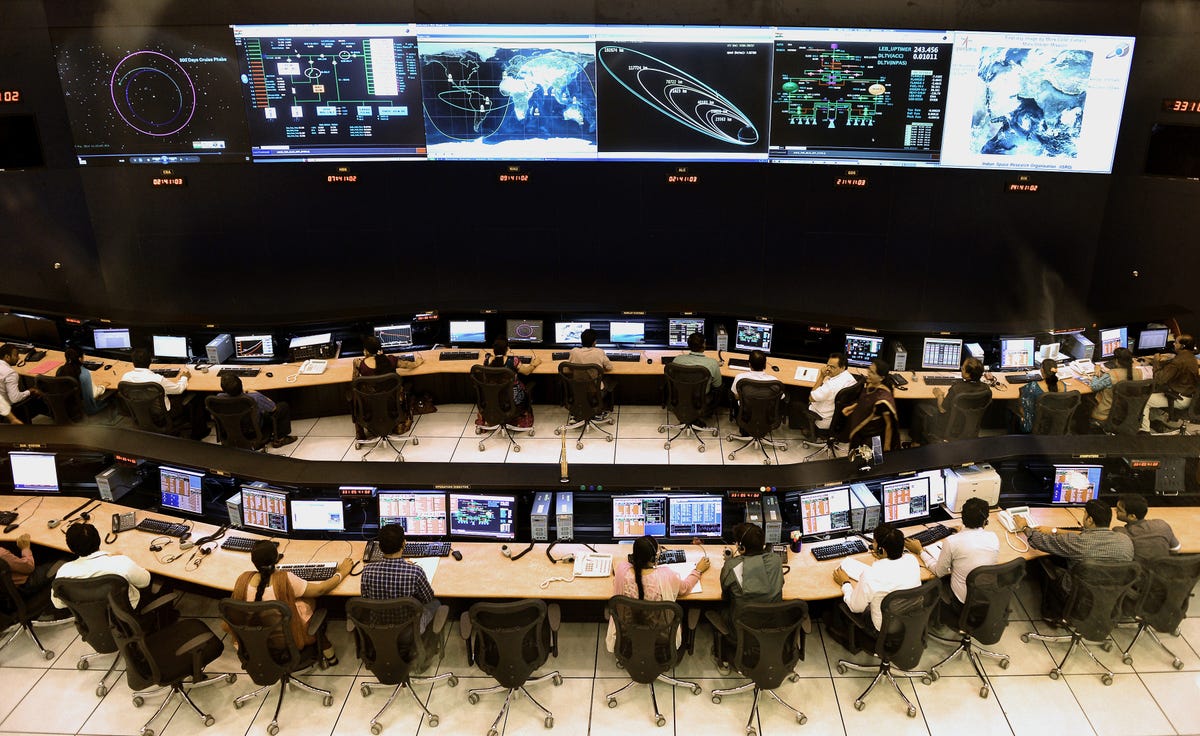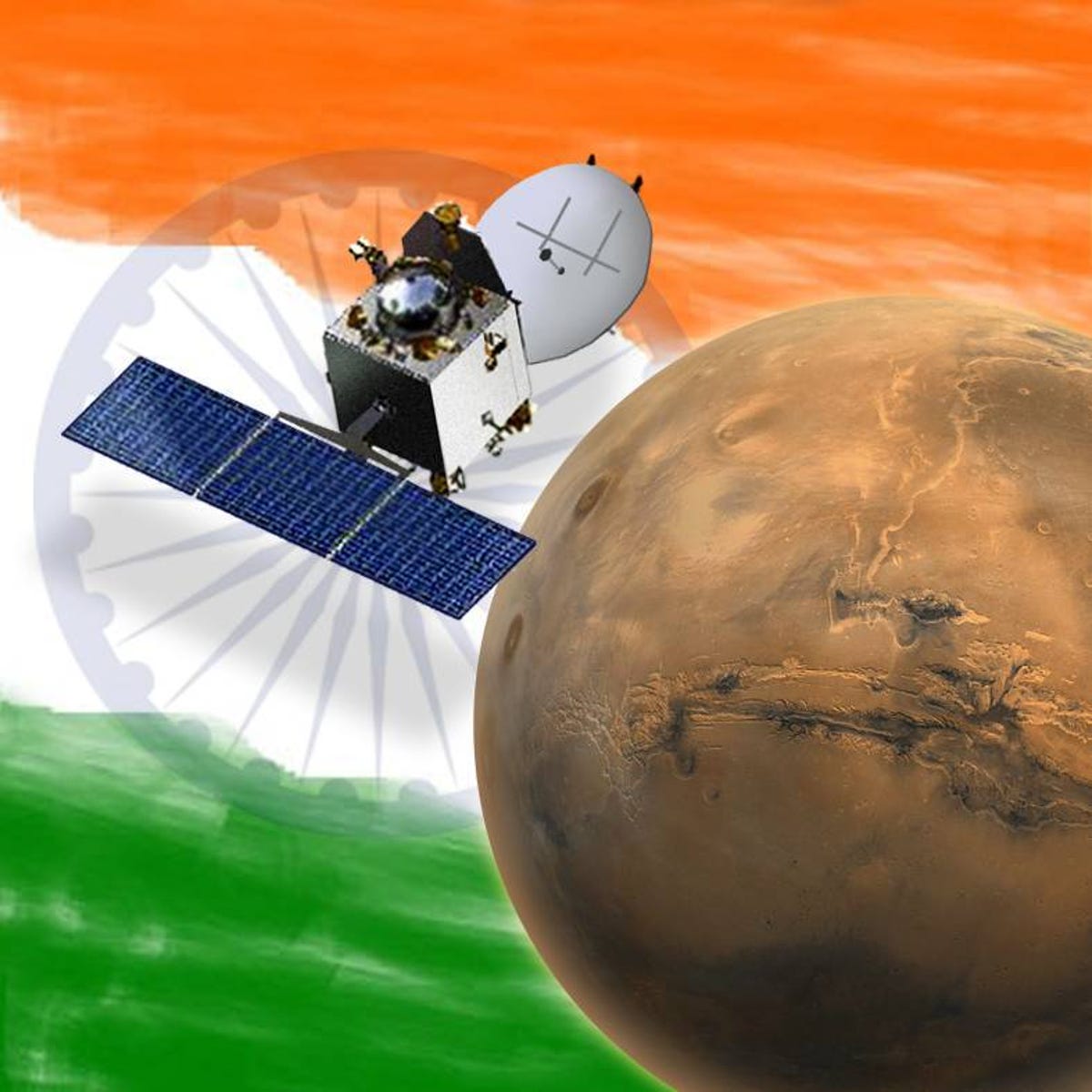India's space agency says the Mangalyaan orbiter has run out of fuel and is "non-recoverable."
Monisha Ravisetti
Oct. 3, 2022

In 2013, India's space agency sent a spacecraft to enter Martian orbit.
In 2014, it did, and on Monday, it said goodbye.
On Sept. 24, 2014, the Indian Space Research Organization made history.
A year earlier, the country's premier space agency blasted a little spacecraft toward Mars, hoping to punch the boxy probe into the red planet's orbit and hover it alongside NASA's state-of-the-art Mars Reconnaissance Orbiter and ESA's inventive Mars Express.
This, at the time, was an ambitious goal.
India had yet to enter the interplanetary game, and allotted only a mere $74 million (4.5 billion rupees) to achieve what the US once did with nearly 10 times that. Even Christopher Nolan budgeted far more to produce his glorious, space-y film, Interstellar and Boeing's cheapest commercial airplane costs an extra few million.
Then came Sept. 24, 2014.
ISRO's spacecraft, known as Mangalyaan, officially entered Martian orbit as part of the Mars Orbiter Mission, making India the fourth nation to insert a robot into Mars' gravitational whirlpool -- and the first to do so on its maiden try. But, as the belabored saying goes, all good things must come to an end.
This week, India bid an inevitable farewell to Mangalyaan, which translates from Hindi to "Mars craft."
After eight incredible years of service studying the rocky world's atmosphere and testing key technologies from the sky -- a much longer lifetime than the agency expected -- Mangalyaan ran out of fuel and battery power.
The culprit, scientists believe, might've partly been an unfortunate back-to-back sequence of solar eclipses. Mangalyaan is solar powered and therefore couldn't charge back up without the power of the sun. Starting now, it will slowly drift toward Mars' surface in silence.
"The spacecraft is non-recoverable and attained its end-of-life," ISRO said in a statement Monday, emphasizing that "the mission will be ever-regarded as a remarkable technological and scientific feat in the history of planetary exploration."
Mangalyaan's legacy
ISRO's Martian space explorer was a trooper.
Once Mangalyaan blasted off from Earth almost a decade ago, the spacecraft's team expected to say goodbye to its muse in about six months. Yet, as ISRO notes, "despite being designed for a life span of six months as a technology demonstrator, the Mars Orbiter Mission has lived for about eight years in the Martian orbit with a gamut of significant scientific results."
Not only did Mangalyaan help scientists understand elusive Martian quirks like the planet's towering dust storms and create a detailed atlas of its icy poles, but eventually, the craft's lens transcended the Martian vicinity to shed light on other parts of our solar system too.
Mangalyaan, ISRO highlights in a sort of obituary, managed to decode secrets about our sun's corona before losing contact with ground control. And during a national meeting held last week to discuss the mission's finale, the team made sure to reminisce about the more human consequences of Mangalyaan's legacy too.


Indian scientists and ISRO engineers monitor the Mars Orbiter Mission at the agency's tracking center in 2013.
A rocky road to the rocky world
It's poignant to think about Mangalyaan's everlasting imprint on space exploration because, around the time when the craft left Earth, reporters, scientists and space enthusiasts worldwide predicted a variety of directions in which that imprint could bend.
Most opinions were wide-eyed.
BBC News openly called India's Mars mission "cheap and thrilling," because the country's space program "succeeded at the first attempt where others have failed," by sending an operational mission to Martian orbit. Regarding that low cost, ISRO managed to keep things "simple," the publication stated, attempting to get the biggest bang for its buck.
India accomplished its Martian orbital endeavor with about 1/10 what it once costed the US.ISRO/NASA
For instance, Mangalyaan was armed with methane detectors meant to answer some of the most pressing questions about Mars' atmosphere, like whether methane-producing bugs might exist somewhere on the planet, thus offering proof of extraterrestrial life.
"The mission is also credited with the discovery of 'suprathermal' Argon-40 atoms in the Martian exosphere, which gave some clue on one of the potential mechanisms for the escape of atmosphere from Mars," ISRO said.
Some opinions were well-intentioned, but missed the mark.
In 2014, a New York Times sketch about Mangalyaan erupted in controversy because it teased the fact that India is soon to join the "elite space club." Many found it distasteful because the character representing India was wearing a traditional dhoti and turban as well as holding a cow on a leash while knocking on the door of a so-called "elite space club." Inside, two white men looked perplexed. One held a newspaper headlined "India's Mars Mission."
In an apology letter, a Times editor said the "intent of the cartoonist, Heng Kim Song, was to highlight how space exploration is no longer the exclusive domain of rich, Western countries," though Indian reporters still felt the graphic marred the sentiment.
On the flip side, ISRO met its fair share of criticism.
Some argue that Mangalyaan's lack of scientific publications -- after five years it'd only produced about 27 -- goes to show the agency was in a rush to hastily get the probe up there. Though as a response to that, others contend that Mangalyaan was meant to be a six-month-long technology demonstration and just so happened to outlive its expected lifetime. Maybe even those 27 publications are a superb achievement, in that case.
By trying to compete with wealthier nations' interplanetary space missions, some have also suggested the agency spent money on space exploration that could've better been leveraged for issues closer to home. Things like health care innovation, infrastructure development and food insecurity solutions that space organizations like NASA or Roscosmos don't have to consider, due to their residence in privileged countries.
As a counterargument, however, in 2013, Indian journalist Samanth Subramanian wrote in The New Yorker that "Mangalyaan's 73-million-dollar budget is a pittance compared to the 20 billion dollars that India will spend this year to provide subsidized food to two out of every three of its citizens, or the $5.3 billion that will be spent this year on a rural employment plan."
It's undoubtedly difficult to measure the benefits and costs -- particularly economic ones -- that come from a space mission. But now, at the end of it all, it'd be remiss to exclude the ultimate payoff that came from Mangalyaan's success.
The existence of this spacecraft spurred the creation of jobs, the mission's unique insights enhanced the field of astronomy, and the project's culmination exuded an evocative message.
Adventuring into space needn't solely be based on wealth, power or privilege, but also on the intrinsic human impulse to explore.
First published on Oct. 3, 2022
On Sept. 24, 2014, the Indian Space Research Organization made history.
A year earlier, the country's premier space agency blasted a little spacecraft toward Mars, hoping to punch the boxy probe into the red planet's orbit and hover it alongside NASA's state-of-the-art Mars Reconnaissance Orbiter and ESA's inventive Mars Express.
This, at the time, was an ambitious goal.
India had yet to enter the interplanetary game, and allotted only a mere $74 million (4.5 billion rupees) to achieve what the US once did with nearly 10 times that. Even Christopher Nolan budgeted far more to produce his glorious, space-y film, Interstellar and Boeing's cheapest commercial airplane costs an extra few million.
Then came Sept. 24, 2014.
ISRO's spacecraft, known as Mangalyaan, officially entered Martian orbit as part of the Mars Orbiter Mission, making India the fourth nation to insert a robot into Mars' gravitational whirlpool -- and the first to do so on its maiden try. But, as the belabored saying goes, all good things must come to an end.
This week, India bid an inevitable farewell to Mangalyaan, which translates from Hindi to "Mars craft."
After eight incredible years of service studying the rocky world's atmosphere and testing key technologies from the sky -- a much longer lifetime than the agency expected -- Mangalyaan ran out of fuel and battery power.
The culprit, scientists believe, might've partly been an unfortunate back-to-back sequence of solar eclipses. Mangalyaan is solar powered and therefore couldn't charge back up without the power of the sun. Starting now, it will slowly drift toward Mars' surface in silence.
"The spacecraft is non-recoverable and attained its end-of-life," ISRO said in a statement Monday, emphasizing that "the mission will be ever-regarded as a remarkable technological and scientific feat in the history of planetary exploration."
Mangalyaan's legacy
ISRO's Martian space explorer was a trooper.
Once Mangalyaan blasted off from Earth almost a decade ago, the spacecraft's team expected to say goodbye to its muse in about six months. Yet, as ISRO notes, "despite being designed for a life span of six months as a technology demonstrator, the Mars Orbiter Mission has lived for about eight years in the Martian orbit with a gamut of significant scientific results."
Not only did Mangalyaan help scientists understand elusive Martian quirks like the planet's towering dust storms and create a detailed atlas of its icy poles, but eventually, the craft's lens transcended the Martian vicinity to shed light on other parts of our solar system too.
Mangalyaan, ISRO highlights in a sort of obituary, managed to decode secrets about our sun's corona before losing contact with ground control. And during a national meeting held last week to discuss the mission's finale, the team made sure to reminisce about the more human consequences of Mangalyaan's legacy too.

Kiran Kumar, former chairman of ISRO and key designer for India's Mars mission stands before the first ever images of Mars taken by an Indian space craft.
Getty Images
So far, the agency said, more than 7,200 users have registered to download Mangalyaan's data from ISRO's online archive, 400 of whom are international, and about 27,000 downloads of varying sizes have been carried out already.
"The mission has also contributed to human resource generation in the domain of planetary sciences," ISRO said. "It has generated several Ph.D. holders, while many of the research scholars are using the data from the mission to pursue their doctoral work."
So far, the agency said, more than 7,200 users have registered to download Mangalyaan's data from ISRO's online archive, 400 of whom are international, and about 27,000 downloads of varying sizes have been carried out already.
"The mission has also contributed to human resource generation in the domain of planetary sciences," ISRO said. "It has generated several Ph.D. holders, while many of the research scholars are using the data from the mission to pursue their doctoral work."

Indian scientists and ISRO engineers monitor the Mars Orbiter Mission at the agency's tracking center in 2013.
Getty Images
A rocky road to the rocky world
It's poignant to think about Mangalyaan's everlasting imprint on space exploration because, around the time when the craft left Earth, reporters, scientists and space enthusiasts worldwide predicted a variety of directions in which that imprint could bend.
Most opinions were wide-eyed.
BBC News openly called India's Mars mission "cheap and thrilling," because the country's space program "succeeded at the first attempt where others have failed," by sending an operational mission to Martian orbit. Regarding that low cost, ISRO managed to keep things "simple," the publication stated, attempting to get the biggest bang for its buck.

India accomplished its Martian orbital endeavor with about 1/10 what it once costed the US.ISRO/NASA
For instance, Mangalyaan was armed with methane detectors meant to answer some of the most pressing questions about Mars' atmosphere, like whether methane-producing bugs might exist somewhere on the planet, thus offering proof of extraterrestrial life.
"The mission is also credited with the discovery of 'suprathermal' Argon-40 atoms in the Martian exosphere, which gave some clue on one of the potential mechanisms for the escape of atmosphere from Mars," ISRO said.
Some opinions were well-intentioned, but missed the mark.
In 2014, a New York Times sketch about Mangalyaan erupted in controversy because it teased the fact that India is soon to join the "elite space club." Many found it distasteful because the character representing India was wearing a traditional dhoti and turban as well as holding a cow on a leash while knocking on the door of a so-called "elite space club." Inside, two white men looked perplexed. One held a newspaper headlined "India's Mars Mission."
In an apology letter, a Times editor said the "intent of the cartoonist, Heng Kim Song, was to highlight how space exploration is no longer the exclusive domain of rich, Western countries," though Indian reporters still felt the graphic marred the sentiment.
On the flip side, ISRO met its fair share of criticism.
Some argue that Mangalyaan's lack of scientific publications -- after five years it'd only produced about 27 -- goes to show the agency was in a rush to hastily get the probe up there. Though as a response to that, others contend that Mangalyaan was meant to be a six-month-long technology demonstration and just so happened to outlive its expected lifetime. Maybe even those 27 publications are a superb achievement, in that case.
By trying to compete with wealthier nations' interplanetary space missions, some have also suggested the agency spent money on space exploration that could've better been leveraged for issues closer to home. Things like health care innovation, infrastructure development and food insecurity solutions that space organizations like NASA or Roscosmos don't have to consider, due to their residence in privileged countries.
As a counterargument, however, in 2013, Indian journalist Samanth Subramanian wrote in The New Yorker that "Mangalyaan's 73-million-dollar budget is a pittance compared to the 20 billion dollars that India will spend this year to provide subsidized food to two out of every three of its citizens, or the $5.3 billion that will be spent this year on a rural employment plan."
It's undoubtedly difficult to measure the benefits and costs -- particularly economic ones -- that come from a space mission. But now, at the end of it all, it'd be remiss to exclude the ultimate payoff that came from Mangalyaan's success.
The existence of this spacecraft spurred the creation of jobs, the mission's unique insights enhanced the field of astronomy, and the project's culmination exuded an evocative message.
Adventuring into space needn't solely be based on wealth, power or privilege, but also on the intrinsic human impulse to explore.
First published on Oct. 3, 2022
No comments:
Post a Comment